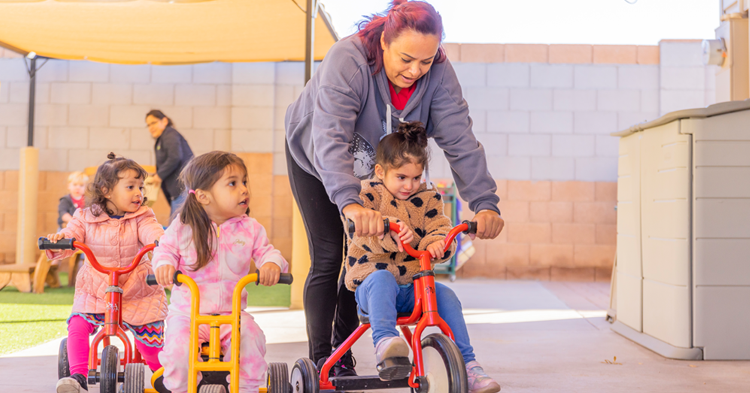As an early childhood educator, you’re probably already aware of the benefits of active physical play for young children. (If you want to learn more, check out these links about the brain boosting impacts and social and emotional benefits of active play.)
Whether you work with infants, toddlers or preschoolers, you have a lot on your plate. With all of the other things competing for your attention, has active play become an afterthought?
If you’re looking for fresh ideas or just hungry for more knowledge, we have five tips to enhance active play.
1. Include active play times throughout the daily schedule
Children are most active during the first 10-15 minutes of outdoor play. Research shows multiple outdoor play times throughout the day help children get the most exercise.
Active Play: How much is enough?
Using the guidelines below, consider breaking up the time into multiple, shorter active play blocks for the most benefit.
Infants: tummy time with supervision and when safe and appropriate, 4 times per day or more
Toddlers: 90 minutes per day or more
Preschoolers: 120 minutes per day or more
(Source: Empower Standards, Arizona Department of Health Services)
2. Get outside every day, weather permitting
Arizona’s weather varies from mountain to desert and from season to season. But children still need active play, even when weather is not ideal. As the old Scandinavian saying goes, “There is no such thing as bad weather, only bad clothes.”
Children who are dressed appropriately can play outdoors, even in warmer and colder weather. With the right footwear, children can go outdoors and experience the joy of puddles after a rain. Just be sure to wipe down play equipment after a rain to reduce the chance of slips and falls. Or, to avoid the unfortunate experience of ending up seated in a puddle at the bottom of the slide!
Work with parents to ensure children have the right clothing and footwear for outdoor play year-round. It helps to have extra items on hand in case busy families forget. To build up a stock of extras, ask families if they would be willing to donate items like winter coats, gloves and rain boots their children have outgrown. Or check your local thrift store for gently used items to keep on hand.
Unless there is active rain or snowfall, a weather warning or health warning for your area, make sure children get outdoors daily. Stay informed by signing up for alerts from the National Weather Service. During hot summer days, avoid the hottest part of the day by moving outdoor play early in the morning and later in the afternoon.
3. During very bad weather, get kids moving indoors
When very bad weather prevents you from going outdoors, don’t let that stop you from getting kids moving. There are lots of ways to keep kids active indoors.
If possible, move to a large indoor space for active play. Typical room arrangements don’t allow for large muscle movements like running and jumping. If your program has an extra room or space, consider using that for indoor active play.
Licensing tip.
Make sure all play areas are licensed. If you’re not sure, check with your Arizona Department of Health Services (ADHS) compliance officer.
- Add portable equipment to get kids engaged and moving. It doesn’t need to be fancy. Mats and tunnels promote scooting and crawling for the youngest learners. Toddlers love tossing and catching balls and playing beanbag games. With preschoolers, add jump ropes, hula hoops and ring toss games to keep the action going.
- Mix it up with different movement activities. Check out this video for active play ideas using just a roll of tape or string.
4. Get in on the fun
Children move more, learn more, and get more out of active play when you’re involved. Try the following:
- Lead heart-pumping activities like friendly competitions, races, and games. Watch this video to see how one program used relay games to support skill building.
And check out this quick video for some fun prompts you can use.
- Watch for opportunities to help children learn new skills. From holding hands to help an early walker balance, to showing a preschooler how to pedal a tricycle, your guidance helps build new skills—and their confidence!
5. Infuse movement throughout the day
In addition to vigorous active play during gross motor times, children also benefit from less intensive movement opportunities throughout the day. Activities like dancing, yoga, balancing and stretching help kids regulate their bodies and focus their minds. Watch this video for ideas from preschool teachers.
Need help getting started?
If you’re a Quality First participant, contact your child care health consultant. Their expert assistance, advice, training and recommendations can help you put new ideas into practice.
Resources around the web
- The Empower Program: Offered through ADHS, this program focuses on supporting the development of healthy habits in child care settings. Visit their website to find standards, professional development and resources on physical activity and other health topics.
- Go NAPSACC: Now offered for free in Arizona, this trusted online tool helps child care programs go the extra mile to support children’s healthy habits. Programs have used Go NAPSACC to improve their menus, add more play into their daily schedules, and educate families about healthy eating and active play. Visit the website to learn more.
If you’re interested in using Go NAPSACC, contact Arizona’s Go NAPSACC representative, Noelle Veilleux Markham at Noelle.Veilleux@azdhs.gov for a registration code. After receiving your code, visit the Join Us page to complete your registration and start using the toolkit.
